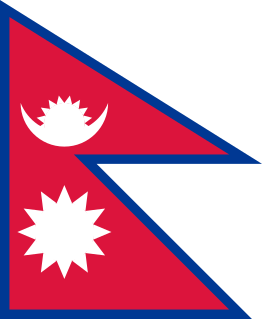
Bhojpur is one of two urban municipalities in Bhojpur District of Province No. 1 of Nepal. It was established on 18 May 2014 merging the existing Bhaisipankha, Bokhim, Bhojpur, Taksar Village Development Committees It is the district headquarters of Bhojpur District, a hilly/mountainous district in Province No. 1. At the time of the 2011 Nepal census it had a population of 27204 with an area of 159.51 square kilometres (61.59 sq mi).

Khandbari is the district headquarters of Sankhuwasabha District in Kosi Zone of north-eastern Nepal. The 2011 Nepal census counted 26,301 population.

Baikunthe Nepali: बैकुण्ठे is a village development committee in Bhojpur District in the Kosi Zone of eastern Nepal. At the time of the 1991 Nepal census it had a population of 3167 persons living in 575 individual households.

Annapurna is a village development committee in Bhojpur District in the Kosi Zone of eastern Nepal. At the time of the 1991 Nepal census it had a population of 1856 persons living in 360 individual households.

Bhaisipankha is a Market in Bhojpur Municipality in Bhojpur District in the Kosi Zone of eastern Nepal. The formerly Village development committee was merged to form new municipality since 18 May 2014. At the time of the 1991 Nepal census it had a population of 3077 persons living in 555 individual households.
Bhubal is a village development committee in Bhojpur District in the Kosi Zone of eastern Nepal. At the time of the 1991 Nepal census it had a population of 2150.

Bhulke is a village development committee in Bhojpur District in the Kosi Zone of eastern Nepal. At the time of the 2001 Nepal census it had a population of 2,847 living in 513 individual households.

Dobhane is a village development committee in Bhojpur District in the Kosi Zone of eastern Nepal. At the time of the 1991 Nepal census it had a population of 4760 persons living in 860 individual households.

Dummana is a village development committee in Bhojpur District in the Kosi Zone of eastern Nepal. At the time of the 1991 Nepal census it had a population of 4331 persons living in 731 individual households.

Khatamma is a village development committee in Bhojpur District in the Kosi Zone of eastern Nepal. At the time of the 1991 Nepal census it had a population of 2151 persons living in 407 individual households.

Khawa is a village development committee in Bhojpur District in the Kosi Zone of eastern Nepal. At the time of the 1991 Nepal census it had a population of 2610 persons living in 494 individual households.h

Kot is a village development committee in Bhojpur District in the Kosi Zone of eastern Nepal. At the time of the 1991 Nepal census it had a population of 4485.

Kulung is a village development committee in Bhojpur District in the Kosi Zone of eastern Nepal. At the time of the 1991 Nepal census it had a population of 4095 persons living in 746 individual households. The postal code of Kulung bhojpur is 57001. The Kulung are one of the indigenous communities of Nepal, as well as parts of northeastern Sikkim and Darjeeling district of India, having their own Kulung language, culture, history and tradition. This name comes after their majority there but nowadays there is mixed locality.

Mane Bhanjyang is a village development committee in Bhojpur District in the Kosi Zone of eastern Nepal. At the time of the 1991 Nepal census it had a population of 2832 persons living in 503 individual households.

Nepaledanda is a village development committee in Bhojpur District in the Kosi Zone of eastern Nepal. At the time of the 1991 Nepal census it had a population of 3325 persons living in 659 individual households.

Okhre is a village development committee in Bhojpur District in the Kosi Zone of eastern Nepal. At the time of the 1991 Nepal census it had a population of 2729 persons living in 534 individual households. Here lies a calcium ore.

Thidingkha is a village development committee in Bhojpur District in the Kosi Zone of eastern Nepal. At the time of the 1991 Nepal census it had a population of 2293.

Timma is a village development committee in Bhojpur District in the Kosi Zone of eastern Nepal. At the time of the 1991 Nepal census it had a population of 3336 persons living in 621 individual households.
Tiwari Bhanjyang is a village development committee in Bhojpur District in the Kosi Zone of eastern Nepal. At the time of the 1991 Nepal census it had a population of 3004 persons living in 534 individual households. The mayor of this VDC is Manit Nidhi Tiwari.

Yaku (याकु) is a village development committee in Bhojpur District in the Kosi Zone of eastern Nepal. It is inhabited mainly by Dhakal (श्रेष्ठ); a few other castes are found. Yaku is also known to be birta of the shresthas. It is a remote place and it has produced a number of well-known figures in Nepal, including academicians, bureaucrats and politicians.







